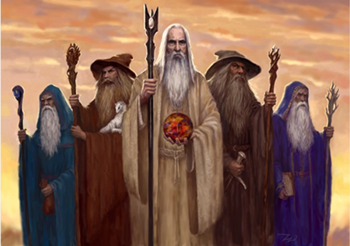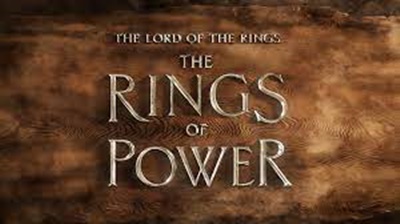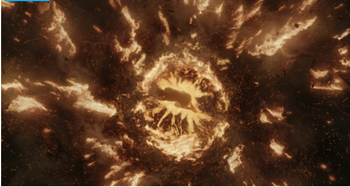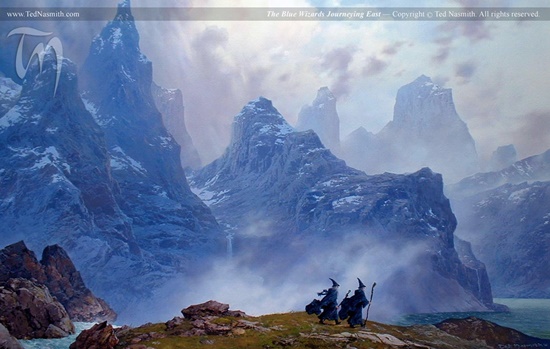Talking The Rings of Power – The Istari
 So – season one of Amazon’s massively expensive Second Age epic, The Rings of Power, has fully aired. I have mixed feelings about it. It’s definitely better than MTV’s teen-drama take on Shannara (The Sword of Shannara is one of my all-time favorite novels). But I liked the Wheel of Time better than Rings. And that certainly had some flaws. So, still sorting through things.
So – season one of Amazon’s massively expensive Second Age epic, The Rings of Power, has fully aired. I have mixed feelings about it. It’s definitely better than MTV’s teen-drama take on Shannara (The Sword of Shannara is one of my all-time favorite novels). But I liked the Wheel of Time better than Rings. And that certainly had some flaws. So, still sorting through things.
I’m going to do a re-watch, really paying attention and trying to be a little less disappointed at the approach they took. I will say, if you’re a fan of The Silmarillion, it’s worth watching to see some of that book come to life – even if it could have been done more faithfully.
For the next month-ish, I’m going to identify some key aspects of the show, and look at some of the good and the bad for each. And the main part will be Tinkering With Tolkien – some discussion of what Tolkien actually wrote about the topic of the week.
The Silmarillion is my favorite Tolkien novel. I love the lore and the history of Middle Earth. The wars, the stories of dwarves, and elves; it’s incredible world-building. I like reading about what he created, more than reading the actual books straight through. I enjoy reading the appendices to the Lord of the Rings, and the events in the timelines. Unfinished Tales, which elaborated on the five main books, is actually my favorite Tolkien book of them all.
The events of the show take place in the Second Age, which was long before the events of The Hobbitt, and The Lord of the Rings. The Silmarillion tells of the First and Second Age, and some of the Third (and Fourth) Age.
But Amazon didn’t get the rights to The Silmarillion (I talked about The Tolkien Estate being annoying in that regard, in last week’s column). They have to use what is contained in the four other books. Fortunately, The Return of the King includes the awesome Appendices, which have lots of info that can be mined for the show.
 And, they made up a whole bunch of stuff on their own. I’d say well over half of season one was Amazon, not Book Tolkien. That’s a huge part of why I’ve said this series is more like fan fiction, than a genuine adaptation, or pastiche. Peter Jackson’s Lord of the Rings was an actual Tolkien adaptation. There’s a big difference, as The Rings of Power has shown us.
And, they made up a whole bunch of stuff on their own. I’d say well over half of season one was Amazon, not Book Tolkien. That’s a huge part of why I’ve said this series is more like fan fiction, than a genuine adaptation, or pastiche. Peter Jackson’s Lord of the Rings was an actual Tolkien adaptation. There’s a big difference, as The Rings of Power has shown us.
Regarding Tinkering with Tolkien: Tolkien didn’t simply just write the history of Middle Earth, start to finish. It changed and evolved over decades. Even after the publication of The Lord of the Rings, he ‘officially’ revised things. And he speculated and adjusted in his writings, up to his death. Even The Silmarillion was Christopher’s version of the various pieces (finished and unfinished) which his father wrote. So, the Tolkien parts are not consistent. But they are legitimately him (or his son working with his father’s writings).
SPOILER ALERT – There will be spoilers. Both from The Silmarillion, and from the show. You have been warned. END OF SPOILER ALERT
THE ISTARI
THE GOOD
I’ve always been interested in The Istari (Elvish for ‘wizard’) – the five wizards sent by the Valar to assist the people of Middle Earth against Sauron. They are Maiar – powerful beings a step below Valar (the Valar are basically gods – with Iluvatar being the omni-everything creator god).
Balrogs are also Maiar. So, you’ve got super spirits fighting for Melkor; and later, some good spirits being sent down to help out the elves, dwarves, and humans, as Sauron begins his rise to power. We briefly saw the Balrog that will shortly drive the dwarves out of Moria (I like to call it Khazad Dum). It was absolutely one of the best parts of the Peter Jackson movies.
The Rings of Power gives us one Istari falling from the sky like a meteor, and suffering some type of amnesia. He doesn’t even speak a language. More on that to follow; as the amnesia thing is not COMPLETELY made -up. Sort of. We’re teased that he may be Sauron, and he’s simply referred to as ‘The Stranger.’ Since Sauron was Melkor’s chief lieutenant, he wouldn’t just be falling out of the sky in the Second Age. That makes it less likely it’s him.
Of course, this show is more than willing to play fast and loose with Tolkien when it wants, so you couldn’t rule that out. But it did make it more plausible that we had an Istari on our hands. Not Sauron.
 The Cultists, who are Sauron followers, – presumably from the East – get on The Stranger’s bad side and find out he’s really one of the Istari, and he lights them up. Afterwards he himself heads off to the East (with an annoying, totally Tolkien Tinkering sidekick). Two of the five Istari were known simply as the Blue Wizards, and they went off to the East (and South). So, Rings of Power did give us an Istari, and sent him off to the East. That’s kinda cool. Even if it’s characteristic of the ‘Time Compression’ which this show does.
The Cultists, who are Sauron followers, – presumably from the East – get on The Stranger’s bad side and find out he’s really one of the Istari, and he lights them up. Afterwards he himself heads off to the East (with an annoying, totally Tolkien Tinkering sidekick). Two of the five Istari were known simply as the Blue Wizards, and they went off to the East (and South). So, Rings of Power did give us an Istari, and sent him off to the East. That’s kinda cool. Even if it’s characteristic of the ‘Time Compression’ which this show does.
THE BAD
One huge thing for me is that he’s dropped into the earth like a flaming meteor. This doesn’t seem like the most effective way for the Valar to send aid. He’s there to help (of course, even with the Time Compression, Sauron hadn’t even come to power yet, so him showing up now seems a little pro-active for the Valar…though, read on). But he has no clue who he is – and he even lets the cultists half-convince him that he’s Sauron. Are the Valar total tools? Complete idiots? No. No, they’re not. I think the show just wanted to tease the ‘Is he Sauron angle.’ Whatever – gotta have drama. But the flaming meteor approach is goofy.
The inclusion of an Istari at this point in the Second Age is totally non-Canon; it seems to exist just to unnecessarily jam harfoots (hobbits) into the show; and the way he arrives is just dumb. It seems Monty Python-esque. Except, as I discuss below, Tolkien does write in an essay about the Blue Wizards arriving around this time. So, no Blue Wizards now in The Silmarillion, and two, not one, came in a later writing. More messing around with Tolkien’s actual words.
But having an Istari here can work (even if it’s totally ruined with the stupid, unnecessary, harfoot story line). But the meteor approach, with almost total amnesia, is silly. Unfinished Tales tells that they came by boat from the West. Cirdan of the Gray Havens saw them arrive. That seems a lot more sensible, if less sensational.
TINKERING WITH TOLKIEN
The Istari are Canonical; no arguing that. Now, they were sent to Middle Earth in the Third Age; about 3,000 years after the Rings of Power were forged – so they don’t actually belong in this series at all (EXCEPT for a little revisionism, discussed below).
But the inclusion of an Istari isn’t jarring (or as undesirable as including frigging harfoots), and it certainly gives some story possibilities.
We all know about Gandalf and Saruman, of course. They played vital roles in The Lord of the Rings. And Gandalf is all over The Hobbit. Only one other wizard was named – Radagast the Brown. He has a minor part in The Fellowship of the Ring, and that’s about it for the official history. Peter Jackson GREATLY played up his role and made him a notable figure in his Hobbit trilogy.
In 1954, Tolkien began preparing an index to follow The Fellowship of the Rings (that didn’t actually happen for over a decade). But as part of this, he wrote a long essay on The Istari, which is our greatest resource on them. It was included, in full, in Unfinished Tales.
In this essay, Gandalf didn’t want to go, and as he showed up to ‘the selection party’ late, he was picked as the third (and final, at that point) member. He said he was too weak and feared Sauron. He was volun-picked anyways.
Radagast was forced on Saruman by Yavanna, who begged that the brown wizard be included. Saruman had no use for Radagast, and even duped him into sending Gandalf into his trap at Orthanc.

And there are two commonly known as ‘The Blue Wizards.’ They are mentioned in less than one sentence in The Lord of the Rings. Tolkien did speculate about them in the essay, and in other writings. Their actual Valinorian names are Alatar and Pallando.
But some years after this essay, Tolkien revised his take on the Blue Wizards, saying they came in the Second Age – presumably around 1600, when Sauron forged the One Ring. They went to the East, and the South, and helped work up the Resistance to the new Dark Lord.
On October 14, 1958, Tolkien wrote a reply to Rhona Beare, answering some questions, which she wanted to pass on to a meeting of fellow Tolkien fans. In it, he wrote:
“I really do not know anything clearly about the other two [wizards] – since they do not concern the history of the North and West. I think they went as emissaries to distant regions, East and South, far out of Númenórean range: missionaries to ‘enemy-occupied’ lands, as it were. What success they had I do not know; but I fear that they failed, as Saruman did, though doubtless in different ways; and I suspect they were founders or beginners of secret cults and ‘magic’ traditions that outlasted the fall of Sauron.”
So, at that point in time, he viewed them as failures in the fight against Sauron. That changed in the last year or two of his life, when, while speculating on Glorfindel, he wrote a bit more about The Blue Wizards, including the following:
They must have had very great influence on the history of the Second Age and Third Age in weakening and disarraying the forces of East… who would both in the Second Age and Third Age otherwise have…outnumbered the West.
A note from Tolkien indicates that the two Blue Wizards came to Middle Earth at the same time as Glorfindel, which was in 1000 Second Age – when the One Ring was forged. So, while there’s only one of them, sending an Istari into The Rings of Power at this point, isn’t totally far-fetched.
 In The Rings of Power, we don’t know who this Istari is. Of course, Gandalf is a popular choice. And I will say that if it is him, it would help explain his fondness and ties to hobbits. I don’t think it is him, though.
In The Rings of Power, we don’t know who this Istari is. Of course, Gandalf is a popular choice. And I will say that if it is him, it would help explain his fondness and ties to hobbits. I don’t think it is him, though.
One of the two Blue Istari is more likely. Of course, they came as a pair. And they headed east with Saruman. The White Wizard came back West, but the two were never heard of again. By all accounts, Saruman did not become corrupted until later, when he began to covet the One Ring, and his jealousy of Gandalf grew (Saruman was not happy that Cirdan gave one of the three Elven rings to Gandalf). Which probably rules out him ‘disposing’ of the Blue Wizards while they journeyed in the East. I do like the sinister connotations of that, though.
But it’s quite possible that The Stranger is none of the five, and this is more ‘free range writing,’ which Amazon certainly seems comfortable with. Spinning a new wizard out of whole cloth wouldn’t really change things significantly from using only one Blue Wizard. The Istari’s adventures in the East are going to be made-up, since even Tolkien himself didn’t know what the two Blue Wizards did.
Having said all that, an Istari, acting in the East (where Rhun is, and where the Blue Wizards at least passed through), could be a neat part of the show. Hopefully he won’t find another tribe of harfoots and we’ll only have to deal with Nori (why they had to use the name of a dwarf in Durin’s Lonely Mountain party is totally beyond me). So, we’ll see how fanciful they get with the Istari. It could be good or bad. But I don’t mind that they included one. And it’s not totally outside of Tolkien to have a Second Age wizard.
The ‘amnesia thing’ does have a little basis in Tolkien (unlike the fire meteor approach). A note in the margin of the Istari essay reads:
“For it is said that being embodied the Istsari had need to learn much anew by slow experience, and though they knew whence they came the memory of the Blessed Realm was to them a vision from far off, for which (so long as they remained true to their mission) they yearned exceedingly. Thus, by enduring of free will the pangs of exile and the deceits of Sauron they might redress the evils of the time.”
The Stranger seems to be yearning to get back to the stars, which could represent Valinor in this show, since he fell out of the sky. And he clearly needs to learn EVERYTHING anew. I don’t know that these changes make things better, but they’re not from totally off the reservation, at least. Just mostly off.
Next Week – If I can muster the energy, next week’s entry will be on the harfoots, who are inextricably tied into The Stranger story line. But I don’t really like hobbits, and they played ZERO part in this story in Tolkien. Harfoots are basically ruining Rings of Power for me, and I’d rather read my phone or get a snack from the kitchen than watch their scenes. So, you get an idea what their essay will be like.
 Bob Byrne’s ‘A (Black) Gat in the Hand’ made its Black Gate debut in 2018 and has returned every summer since.
Bob Byrne’s ‘A (Black) Gat in the Hand’ made its Black Gate debut in 2018 and has returned every summer since.
His ‘The Public Life of Sherlock Holmes’ column ran every Monday morning at Black Gate from March, 2014 through March, 2017. And he irregularly posts on Rex Stout’s gargantuan detective in ‘Nero Wolfe’s Brownstone.’ He is a member of the Praed Street Irregulars, founded www.SolarPons.com (the only website dedicated to the ‘Sherlock Holmes of Praed Street’) and blogs about Holmes and other mystery matters at Almost Holmes.
He organized Black Gate’s award-nominated ‘Discovering Robert E. Howard’ series, as well as the award-winning ‘Hither Came Conan’ series.
He has contributed stories to The MX Book of New Sherlock Holmes Stories – Parts III, IV, V, VI and XXI.
He has written introductions for Steeger Books, and appeared in several magazines, including Black Mask, Sherlock Holmes Mystery Magazine, The Strand Magazine, and Sherlock Magazine.
Why the hate for the Harfoots, they are a peace loving race and want nothing but to live free and be left alone. Give them a chance to grow on you Bob.
No room for silly Harfootsssessss (use your best Gollum voice)
I delayed starting Rings of Power until my family finished our binge rewatch of all four seasons of Stranger Things. Then the question was, Sandman or Rings of Power first? We gave each series one episode to win us over. The writing on Sandman is…well, it’s Gaiman. The writing on Rings of Power couldn’t hold a candle to it. We’ll come back around to Rings in a week or two, probably, but there’s no burning urgency. I’m sure Amazon literally paid the writers, but in my household, when a show’s storytelling just doesn’t grab us, our shorthand is to say, “They didn’t pay the writers.”
The prospect of seeing what they do with one of the Blue Wizards intrigues me more than anything else I’ve seen about the show. My idiosyncratic theory has always been that the Blue Wizards were laying the groundwork for the Dagor Dagorath, far in the future, when Morgoth himself breaks the firmament and returns to Middle Earth. If dealing with Sauron was a big deal that required wizardly assistance, dealing with Sauron’s big boss must surely be bigger.
My other idiosyncratic theory was that Iluvatar had his own reasons for placing the first elves in Cuivienen, on the eastern shore of what eventually becomes Rhun, and placing the first humans in Hildorien, way on the east coast of the whole landmass. The Valar — who meddled constantly in the fates of Iluvatar’s two peoples, often with disastrous unintended consequences — tried to get both populations in their entirety to migrate west, and failed. From the viewpoint of Tolkien’s imagined elvish scholars who sort of narrate the Silmarillion and appendices, everybody who stayed east missed out on the beneficent influence of Valinor and was at increased risk of corruption by Morgoth and Sauron. But I want it to matter that some elves and humans stayed where Iluvatar put them. If it had been my universe, I’d have sent Pallando to help out there. Maybe Alatar, too, on occasion, but he’s got plenty to do in the south.
I was just reading The Doom of Mandos last week. And then The Second Prophecy of Mandos. I kinda like that Turin gets some redemption at the Dagor Dagorath. But I can’t help but think that Feanor’s anger and pride are gonna somehow screw things up for the good guys.
I find the Elves who did not go back to Valinor, interesting.
Wanna write an essay on your second idiosyncratic theory for next Spring’s ‘Talking Tolkien’?
[…] Talking The Rings of Power – The Istari – Black Gate – https://www.blackgate.com/2022/10/23/talking-the-rings-of-power-the-istari/ […]